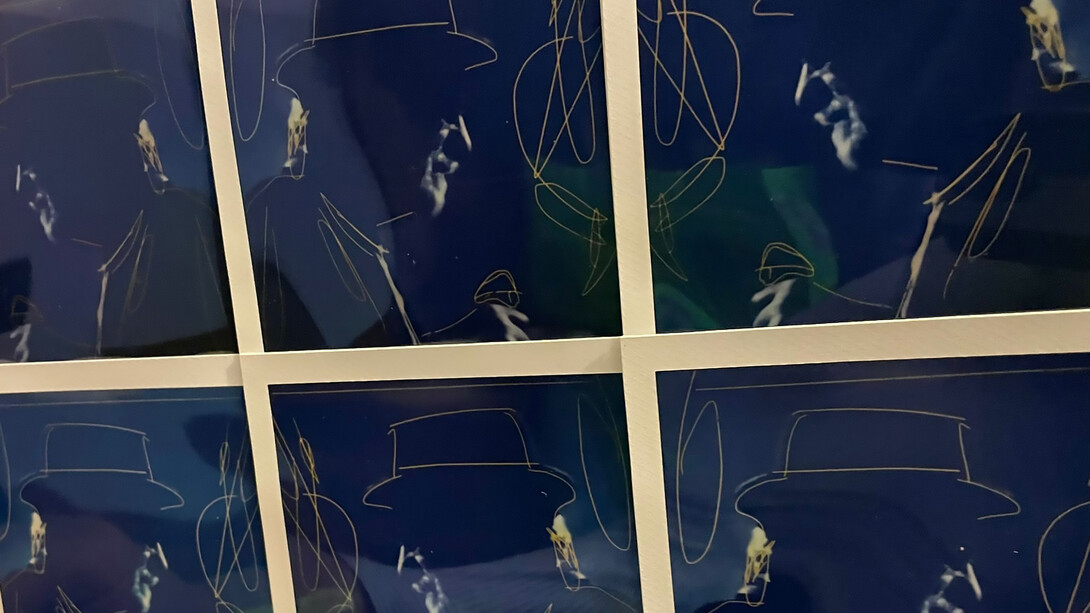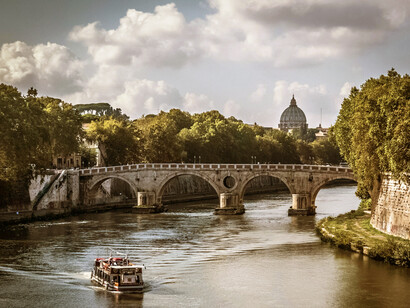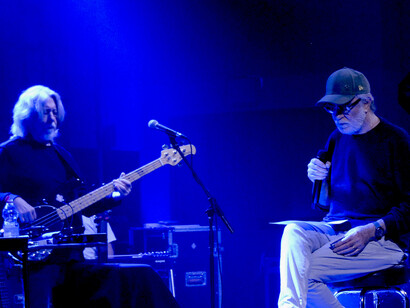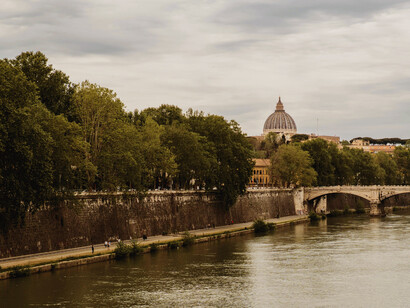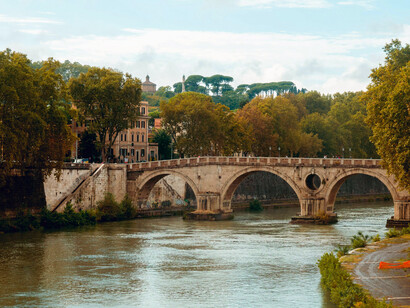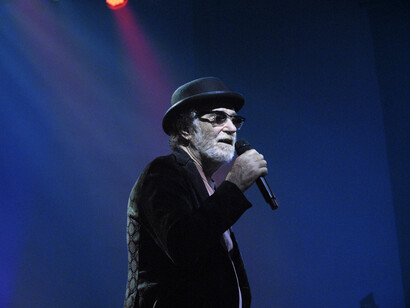On October 14, at sunset, a boat will depart from the pier of Castel Sant’Angelo. But this is not a cruise nor a simple cultural event: it is an attempt to let a story flow on the water. Frames from the Future, curated by Lorena Magliocco and Raffaele Quattrone, organized by Stefano Maina (Rome Boat) with the artistic production of Raffaella Lione, is conceived as an experiment in aesthetic traversal—a device that brings photography, music, and the city into dialogue. Along the route from Castel Sant’Angelo to the Tiber Island, the Tiber itself becomes not just a backdrop but a protagonist, a liquid body reflecting images, lights, and sounds, giving Rome a new, elusive, and more truthful form.
The event does not present itself as a traditional exhibition, nor as a concert or performance. It is rather a hybrid—a visual and auditory narrative unfolding within the moving space of the river. At the heart of this experience are the photographs of Federico and Marco De Gregori, twins and photographers who accompanied their father, Francesco De Gregori, on his latest tour. Their shots, more than documenting a concert, attempt to capture a rhythm, a shared breath: the way music transforms into face, gesture, and light. Their work moves between documentation and poetry, where reportage yields to an exploration of the intimacy of seeing.
The images of the De Gregori brothers are then reinterpreted by the artist Stefano Del Bravo, who intervenes using manipulated Polaroid techniques, layering colors, digital textures, and analog materials. In this act of transformation, the project’s most conceptual dimension emerges: photography as living material, as an unstable archive that rewrites itself each time. Del Bravo does not merely reinterpret; he transforms the images into portals, temporal passages where past and present coexist. His works operate as “frames from the future” in the literal sense—not as prophetic glimpses, but as memories projected forward, visions that ask to be reconsidered.
In the dialogue between the De Gregori brothers’ work and Del Bravo’s intervention, a central theme of contemporary life is evident: memory as construction rather than testimony. The photographs from Francesco De Gregori’s tour are not relics of an event but starting points for a new visual narrative. The shift from reportage to artistic vision produces a semantic shift that affects our relationship with images. Today, photography is no longer merely an act of preservation but a practice of rewriting. Each shot is an open possibility, a material that can be reworked, contaminated, or hybridized. In this sense, Frames from the Future aligns with a line of contemporary art that questions the stability of images and the fixity of artworks.
The event on the Tiber is therefore also a curatorial experiment, taking photographic language out of the neutral spaces of the museum and letting it live in an unstable, constantly moving environment. Water, with its capacity to reflect and distort, becomes the perfect medium to convey the precariousness of contemporary vision.
The boat’s route—from Castel Sant’Angelo to the Tiber Island, passing through Molo Cavour—traces a symbolic itinerary through Rome’s memory. Each stretch of the river corresponds to a fragment of history: baroque bridges, ancient walls, lights spilling from the streets, and seagulls cutting across the water’s surface. Everything becomes part of the scenery. But what matters is not the spectacle of the landscape but the opportunity to see it from a different perspective. Rome, observed from the river, appears different: less monumental, more fragile, and almost suspended between eras. It is a city that reflects upon itself, and in reflecting, questions itself.
Placing an exhibition on water carries a reflection on transience. Water retains nothing, yet embraces everything. It reflects and erases simultaneously. It is a mobile archive, continually renewed. The photographs of the De Gregori brothers and Del Bravo’s manipulations find their natural resonance in this context: like the river, they are images that cannot be fully possessed, vibrating and changing according to the viewer’s gaze. Each reflection, each movement of the boat, alters the perception of the works and reactivates their meaning.
There is also a participatory dimension in this process. The spectator does not observe from a protected distance but is immersed in the space of the work, sharing its movement, light, and time. In this way, Frames from the Future overturns the traditional paradigm of static exhibitions and transforms it into a relational experience. This is not art that illustrates, but art that happens.
The audience becomes part of the narrative, and the city itself—with its bridges and stones—becomes an element of the installation. This recalls site-specific practices, but with a difference: here the “site” is not a fixed location, but a flow.
The choice of the Tiber as exhibition space is not only poetic but also political. It signifies reclaiming a place often perceived as marginal, returning it instead to the city’s cultural life. The river becomes an artery, a place of passage, and a collective memory. In a sense, Frames from the Future reactivates the river’s original function as a connector, as a line that unites and tells stories. Water becomes both medium and metaphor, tool and content simultaneously.
The presence of Eleonora Daniele as godmother and narrator adds another layer of interpretation: oral storytelling, journalism, and the living word intertwine with image and music, creating a hybrid language. It restores a collective dimension to the project, where the narrative belongs not to a single author but is built through the encounter of different media. Within this interplay, a broader reflection emerges on contemporary communication, increasingly intermedial, suspended between reality and representation, experience and narration.
Ultimately, Frames from the Future is a laboratory of perception. It does not offer answers, but questions. What does it mean to see today? How is visual memory built in a time changing at unprecedented speed? And what role can art play in an era of infinite images and fragmented attention? The project does not provide answers but suggests a posture: to look slowly, letting the images breathe, allowing meaning to emerge from movement rather than fixity. The strength of this experiment lies in its openness. Nothing is definitive: photographs, manipulations, reflections on water, and even the music accompanying the journey are part of a constantly evolving flow. The work seems to write itself, each time different, depending on who observes and from which angle. In this sense, the title Frames from the Future refers not so much to time to come but to a time continually renewing itself: the future as a condition of the present, a tension toward something not yet but already pulsing in our gaze.
In its symbolic dimension, the project proposes a possible path for contemporary art: stepping outside enclosed spaces, rediscovering the relationship with the city and community, and accepting impermanence as a language. It does not celebrate but interrogates. It does not monumentalize but traverses. It is a fragile gesture, and therefore powerful: an invitation to view Rome—and perhaps ourselves—as a mobile reflection, an image that changes with light, wind, and the passage of a boat.
At the end of the journey, when the boat reaches the Tiber Island and the lights go out, the impression is of suspended time. The images do not close into an archive but continue to flow in the memory of those who have seen them, like the river that never stops moving. In that moment, it becomes clear that Frames from the Future is not an event but a poetic gesture: a way to restore to art its original function, that of creating connections. Between past and present, between real and imaginary, between water and light, between what has been and what is yet to come.
